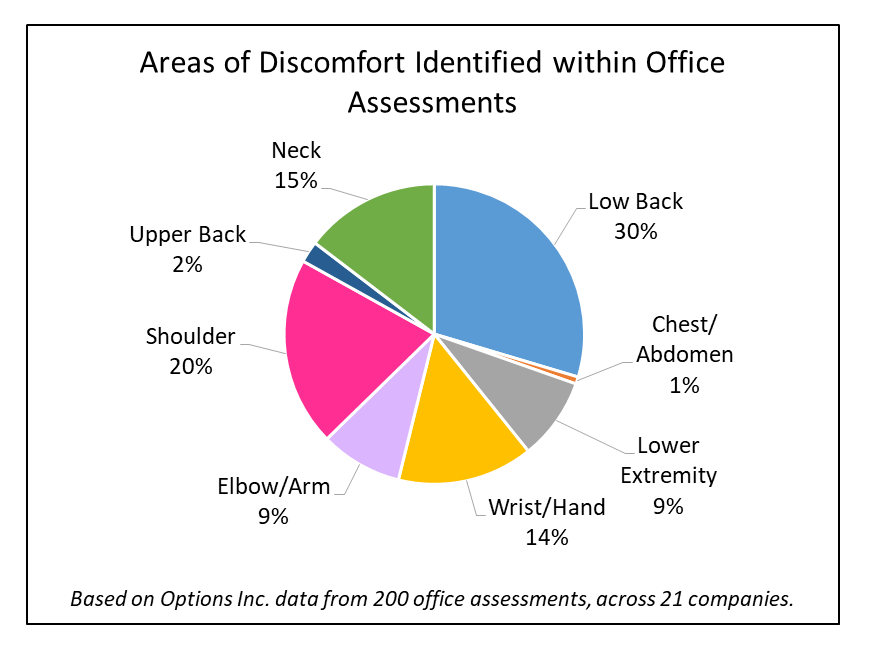Office Technology: What Makes a Workstation Effective?
Written by: Elisha Lemoire, CCPE, Managing Ergonomist
With workers spending more time on computers, the percentage of office workers with musculoskeletal issues is increasing according to a study conducted by the Washington State Department of Labour & Industries. In 2017, Options Incorporated completed 200 office assessments across 21 different companies and our results show the highest areas of discomfort in the office environment are associated with the back (30%) and shoulders (20%). If you are new to office ergonomics, you might be wondering where to get started. What do ergonomic improvements look like? How do you choose the right equipment and will it be expensive? If you are wondering about these things, relax, we are going to share some of our industry trends to help you out.

During our analysis, we discovered the majority of the users we assessed already had equipment available at their workstations, but were still having difficulty. This equipment included a footrest, keyboard tray, document holder, headset, monitor risers and alternative mouse. We discerned that understanding how to set up and adjust this equipment to allow for ideal postures is key. Simply giving people technology and/or equipment will not solve problems as they need to be educated on how to use it in order for it to have an effect.
Previous studies have shown that workstation adjustments alone have no effect on discomfort outcomes and that understanding adjustments of equipment coupled with training has the greatest effect (Amick et al, 2012). For example, across 77 of our case studies for low back discomfort the majority of ergonomic changes were completed onsite utilizing existing equipment. Specifically, 62% of users only required education on chair adjustments to provide ideal support where 36% would benefit from implementation of a footrest.
Is sitting the new smoking? Research has shown that prolonged sitting has been linked to Musculoskeletal Disorders (WHO, 2003), but that prolonged standing can also lead to low back pain (Nelson-Wong & Callaghan, 2014). Assuming workstations are set up in an ergonomically ideal manner one type of station is not superior over the other and using a sit/stand station is not ideal for everyone. Our consulting team was part of an integration phase for an office group implementing sit-stand workstations to collect positive and constructive feedback. Overall, it is important to understand the work tasks and devices used within the workstation to determine the appropriateness of sit-stand workstation as sit-stand workstations are unique and not a one size fits all solution. Additionally, training/education on set up and use of a sit-stand workstation is essential to ensure ideal working postures, set up and continued use of the equipment.
If you are interested in more information on our Office Ergonomic Stats and Analysis from our 200 Office Assessments, contact us for a quote on our one hour workshop on Office Ergonomics: New Trends, Tips, and Solutions.
References:
Amick, B., Menedez, C., Bazzani, L., Robertson, M., DeRango, K., Rooney, T., & Moore, A. (2012). A field intervention examining the impact of an office ergonomics training and a highly adjustable chair on visual symptoms in a public sector organization. Applied Ergonomics, 43, 625-631.
World Health Organization. (2003). Preventing musculoskeletal disorders in the workplace (Protecting Workers’ Health Series No. 5). Geneva, Switzerland.
Nelson-Wong, E., Callaghan, J. P., 2014. Transient Low Back Pain Development During Standing Predicts Future Clinical Low Back Pain in Previously Asymptomatic Individuals. Spine 39, E379- E383.
Contact Us Back to Articles